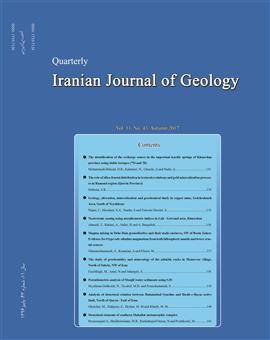-
-
List of Articles
-
Open Access Article
1 - The identification of the recharge source in the important karstic springs of Khuzestan province using stable isotopes (18O and 2H)
HamidReza Mohammadi-Behzad دکتر اسماعیل کلانتری Charchi Arash Nadri -
Open Access Article
2 - The role of silica fractal distribution in textural evolutions and gold mineralization processes in Ramand region (Qazvin Province)
SeydReza Mehrnia -
Open Access Article
3 - Geology, alteration, mineralization and geochemical study in copper mine, Golcheshmeh Area, South of Neyshbour
Fatemeh Najmi Mazaheri Saeid saadat Azam Entezari -
Open Access Article
4 - Neotectonic zoning using morphometric indices in Lali – Gotvand area, Khuzestan
Tayebeh Ahmadi Aziz Rahimi Hojahallah Safari Arash Barjasteh -
Open Access Article
5 - Magma mixing in Dehe Bala granodiorites and their mafic enclaves, SW of Boein Zahra: Evidence for I type calc-alkaline magmatism from both lithospheric mantle and lower crustal sources
Zeynab Gharamohammadi Fatemeh Najmi -
Open Access Article
6 - Magma mixing in Dehe Bala granodiorites and their mafic enclaves, SW of Boein Zahra: Evidence for I type calc-alkaline magmatism from both lithospheric mantle and lower crustal sources
Zeynab Gharamohammadi علی کنعانیان Mohsen Zargham -
Open Access Article
7 - The study of geochemistry and mineralogy of the adakitic rocks in Monavvar village, North of Tabriz, NW of Iran
Mahdieh Fazelihagh Nasir Amel Ahmad Jahangiry -
Open Access Article
8 - Potentiometric analysis of Manjil water sediments using GIS
Nasim Heydarian Dehkordi Mohamad Hassan Tavakol Sima Pourmoammadi -
Open Access Article
9 - Analysis of structural relation between Hatamabad Syncline and Dasht-e-Bayaz active fault, North of Qayen - East of Iran.
Morteza gholchin Morteza Elahpour Mahmoureza Heyhat Mohammahdi Khatib -
Open Access Article
10 - Structural elements of southern Mahallat metamorphic complex
Somayeh Rezaeenejad Mohammadreza Sheikholeslami رامین مالدار Monieh Poshtkouhi
-
The rights to this website are owned by the Raimag Press Management System.
Copyright © 2017-2026







